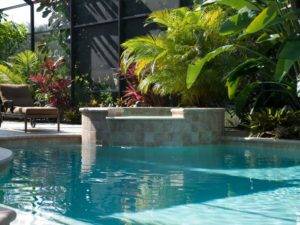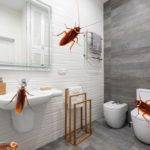From unseen pests to unexpected visitors, the tranquil pool water conceals potential biters. In this article, we explore the overlooked perils that can turn a dip into an unsettling experience. Discover all the tiny little bugs that you should be aware of and how to prevent them, to give you and your kids a safe and worry-free aquatic escape.
Bugs that Bite in Water
There are a couple of bugs that live in water, and are capable of inflicting painful bites. Those bugs can accidentally make their way into your pool. I am sure you don’t want to get bitten even if many of them are non-venomous. So, pay attention to these bugs.
Giant Water Bugs
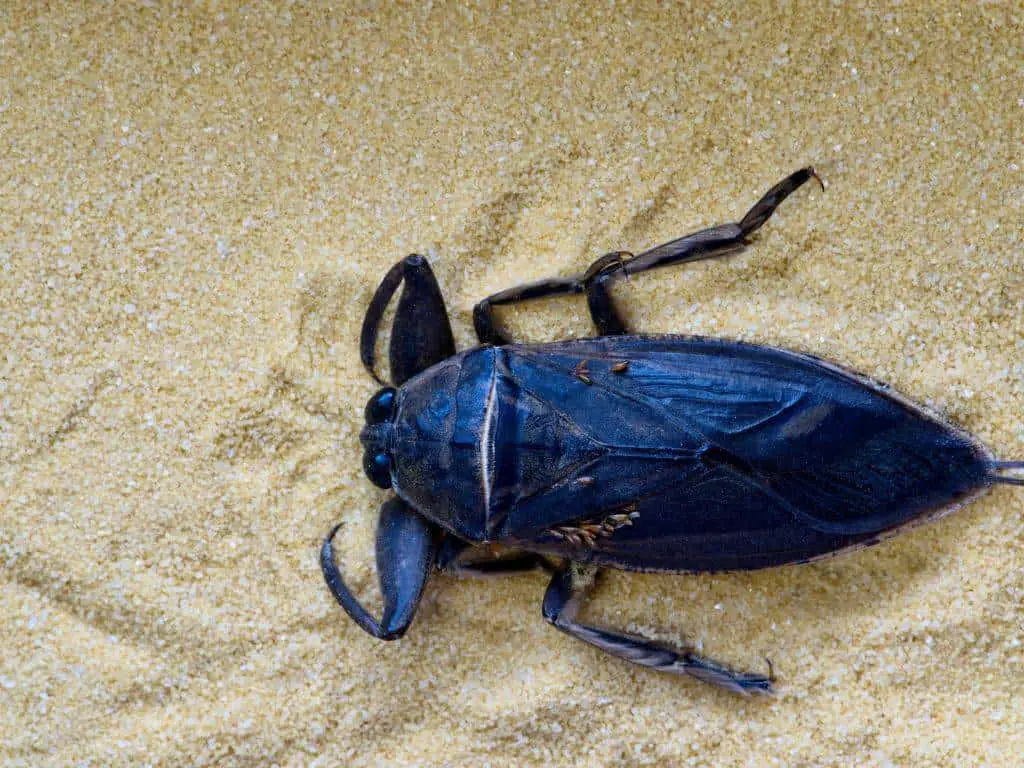
Giant water bugs, resembling cockroaches in appearance, are fascinating aquatic creatures. With a maximum length of 10 cm, these bugs possess distinctive features such as a flat body and prominent compound eyes. Their strong, raptorial forelegs serve as effective tools to capture prey, including small fish and tadpoles.
Typically, giant water bugs live in ponds that have vegetation. They cling onto the plant, hiding and waiting for their prey to get near before ambushing the prey. While grasping its prey, the giant water bug pierce its sharp mouthparts into the prey. It then inject venom to liquefy the organs of the prey, allowing the giant water bugs to suck out the nutrients
Interestingly, giant water bugs can deliver a painful bite to humans using the same mouthparts. This has led to their colloquial nickname, “toe biters.” However, it’s important to note that these bites, while unpleasant, do not pose any significant medical complications.
Under normal circumstances, giant water bugs will not thrive in a swimming pool. The absence of suitable shelter and sustenance prompts them to seek alternative habitats. In fact, they are capable of flight, and will readily relocate once they determine that a water pool does not meet their requirements.
Backswimmers aka Greater Water Boatman
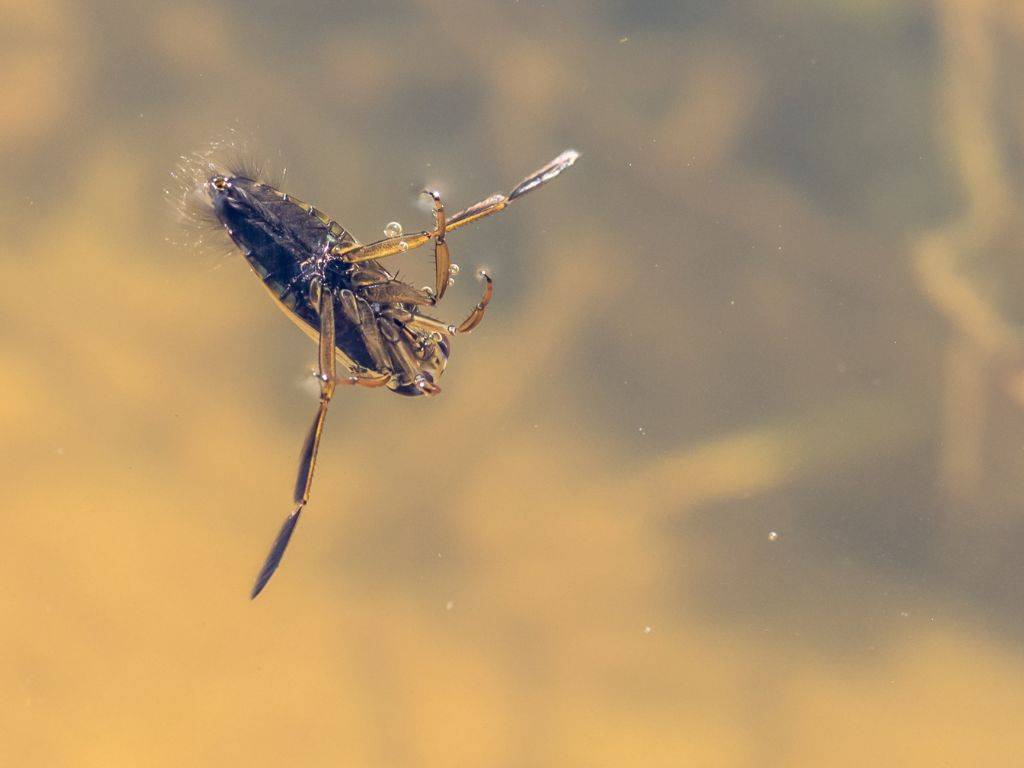
Backswimmers are cockroach-like creatures with a pair of large eyes and unusually long hind legs. They can grow up to 16 mm in length. As implied by their name, this creature swims with its belly facing upwards.
Similar to water bugs, backswimmers prefer to hide in submerged vegetation to ambush their prey. Once their target is captured, the backswimmer skillfully employs its sharp mouthparts to pierce the prey and extract its valuable body fluids.
Equipped with fully developed wings, backswimmers possess the ability to take flight, enabling them to explore and relocate between different bodies of water. While they may occasionally find their way into swimming pools, these artificial environments lack the crucial vegetation required for their survival, making it an unsuitable habitat. Furthermore, the absence of potential prey further discourages their establishment in pools.
While backswimmers can bite humans, it rarely happens. When disturbed, their instinct is to swiftly retreat rather than retaliate with bites. It’s essential to note that backswimmers’ bites lack venom and are not typically a cause for concern.
Water Scorpions
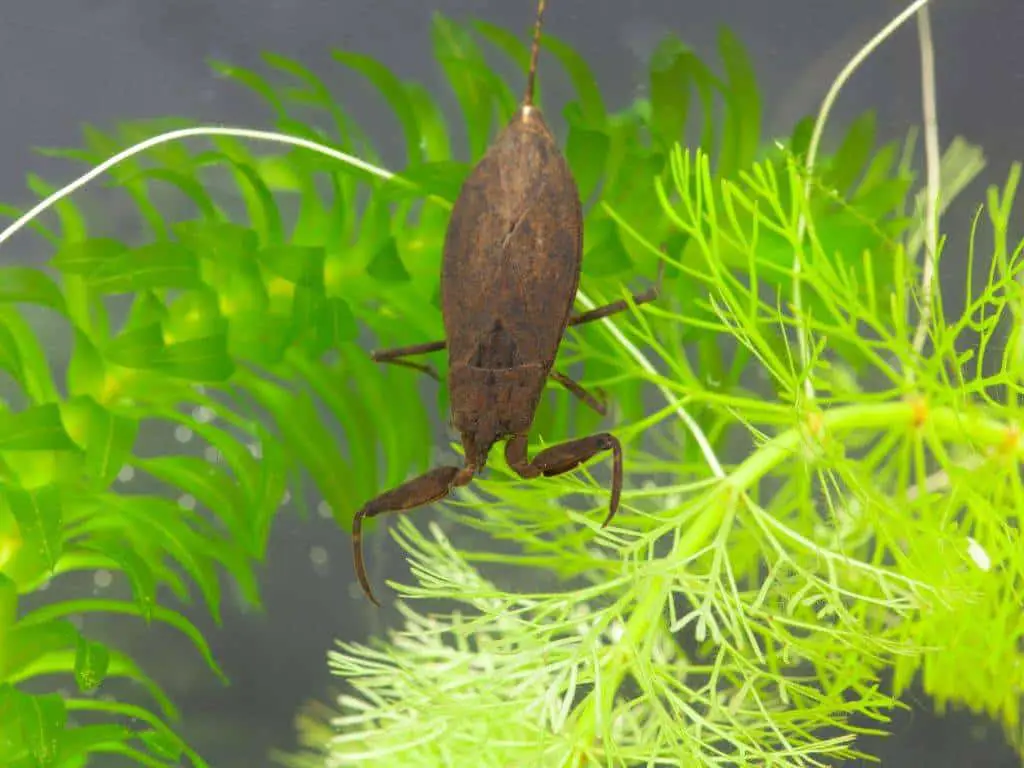
Water scorpions are creatures that bear a striking resemblance to their namesake, the scorpion. They possess stout, raptorial front legs, which they use to snatch their prey with precision. They also have a long, slender tail-like breathing tube, enabling them to breathe while submerged in water. Depending on species, their body length range from 1.5 to 4.5 cm.
Despite their menacing appearance, the tails of water scorpions do not pose any threat to humans. However, it is worth noting that water scorpions may deliver a bite using their sharp mouthparts, resulting in a temporary painful sensation. Fortunately, their bite lacks venom.
Water scorpions have wings, granting them the freedom to explore different environments. Although swimming pools are not the ideal habitat for these creatures due to the lack of suitable hiding places and food sources, it is not impossible for water scorpions to accidentally find their way into such settings while searching for more favorable habitats. Similar to water bugs and backswimmers, once they realize the unsuitability of a pool, they will promptly leave in pursuit of more conducive surroundings.
Centipedes

With a long, snake-like body and over 10 pairs of legs, centipedes can instill fear in many. To make matters worse, they possess the ability to swim in water with their distinct motion.
If there are planters next to your swimming pool, chances are, there are bugs in the planter. As a predator, centipedes can thrive in the planters. Unfortunately, this means occasional trespassing by these creatures into your pool area.
Centipedes have a pair of venomous fangs they use to immobilize their prey. These same fangs serve as a means of defense against potential threats. When disturbed, they do not hesitate to bite.
In the event of a centipede bite, it is crucial to promptly wash and disinfect the wound. Covering it with a band-aid is recommended. Avoid applying home remedies like vinegar or other grandma remedies. If you experience symptoms such as nausea, irregular heartbeat, or any other severe complications, it is essential to seek immediate medical attention from a doctor.
Diving Bell Spiders
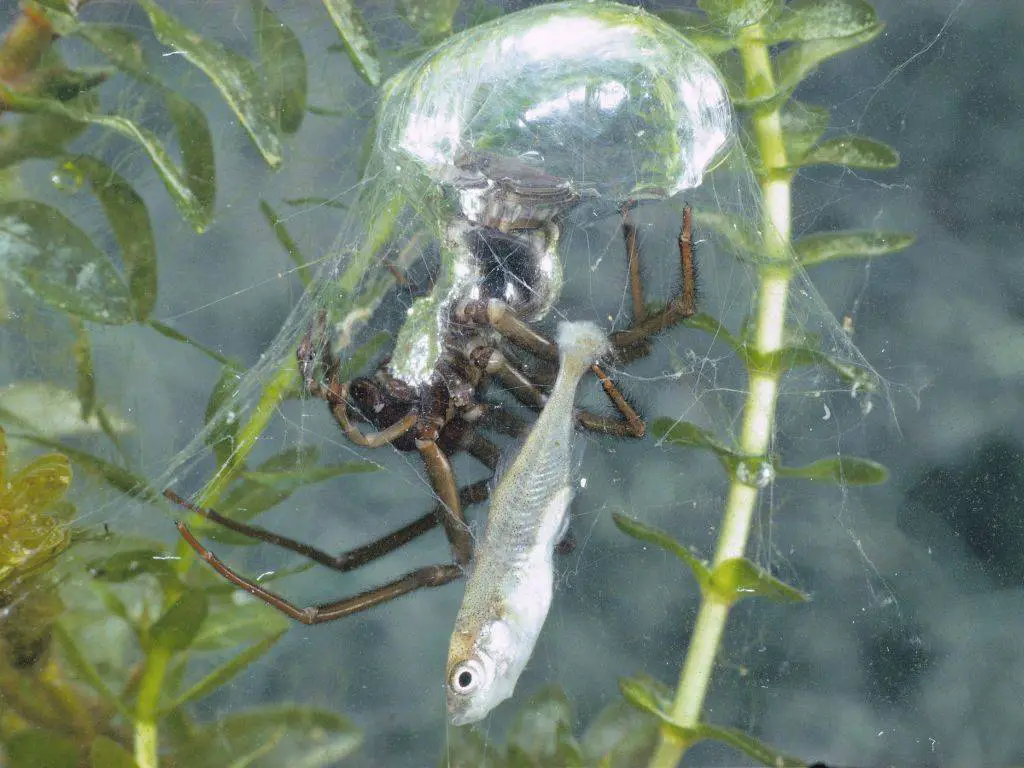
The diving bell spider, scientifically known as Argyroneta aquatica, is a unique spider species that primarily resides underwater. Its body length ranges from 8 to 15 mm.
These spiders construct bell-shaped webs that capture air, enabling them to remain submerged for extended periods. Within these diving bells, they perform all essential activities such as living, feeding, mating, and laying eggs.
Although diving bell spiders are known to deliver painful bites, resulting in localized inflammation, vomiting, and mild feverishness, medical complications are rare. Typically, these symptoms resolve naturally within 5 to 10 days.
Fortunately, encounters with diving bell spiders in pools are uncommon. These spiders are exclusively found in specific regions of Europe and Asia. They naturally inhabit ponds with vegetation, which offer hiding spots and a source of food.
Ants
Everyone knows ants bite. But, no one would expect getting ant bites in water. Well, not if you live near the coast line in certain parts of Oceania.
Polyrhachis sokolova is a species of ant native to Australia and Papua New Guinea. They build nests under the mangrove trees. Adapting to tidal floods, this species has become a good swimmer. They can swim 3 times faster than they walk!
Despite their ability to swim, Polyrhachis sokolova prefers not to do so, if they have the option. Thus, the likelihood of encountering them in your pool is extremely low.
Bugs that Do Not Bite in Water
There aren’t many bugs that bite in water. Most of the aquatic bugs that do live in water do not bite. So, don’t get too worried if you see them in your pool.
Mosquito Larvae and Pupae
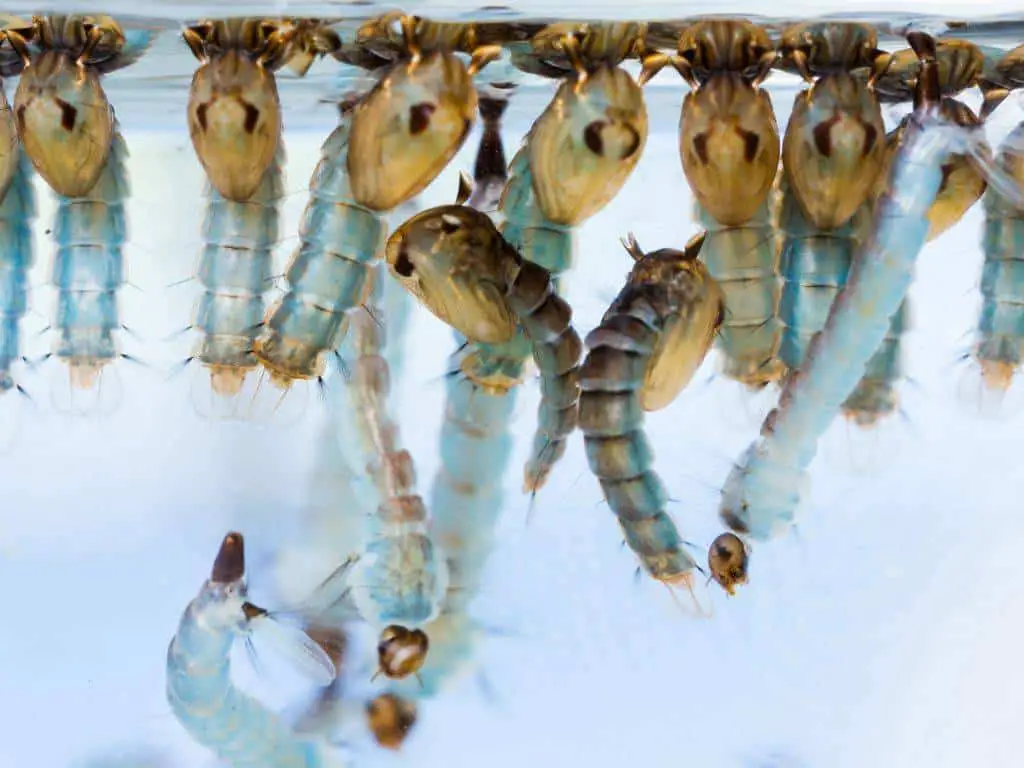
Mosquitoes lay eggs in various water bodies, ranging from stagnant to slow-flowing, and from freshwater to brackish water. It is not uncommon to find mosquito larvae and pupae in water pools. Fortunately, mosquito immatures do not bite.
Mosquito larvae resemble legless worms, and often have a breathing tube at the end of their abdomen for respiration. They primarily feed on organic matter present in the water. Certain species, such as Toxorhynchites spp, have carnivorous larvae that are larger in size. Although they possess strong mandibles to capture prey, typically other mosquito larvae, they do not bite.
Pupae, on the other hand, are dark brown and possess a comma-like shape. They do not have mouths.
Both mosquito larvae and pupae tend to stay near the water surface and rapidly dive when they sense movement, such as a passing shadow.
While these immatures do not bite, having mosquito breeding sites at home can pose a significant issue. Not only do mosquitoes cause nuisance, but they can also transmit deadly diseases through their bites. Approximately 1 million people die each year from mosquito-borne diseases. Therefore, it is crucial to eliminate mosquito breeding sites promptly.
Water Striders
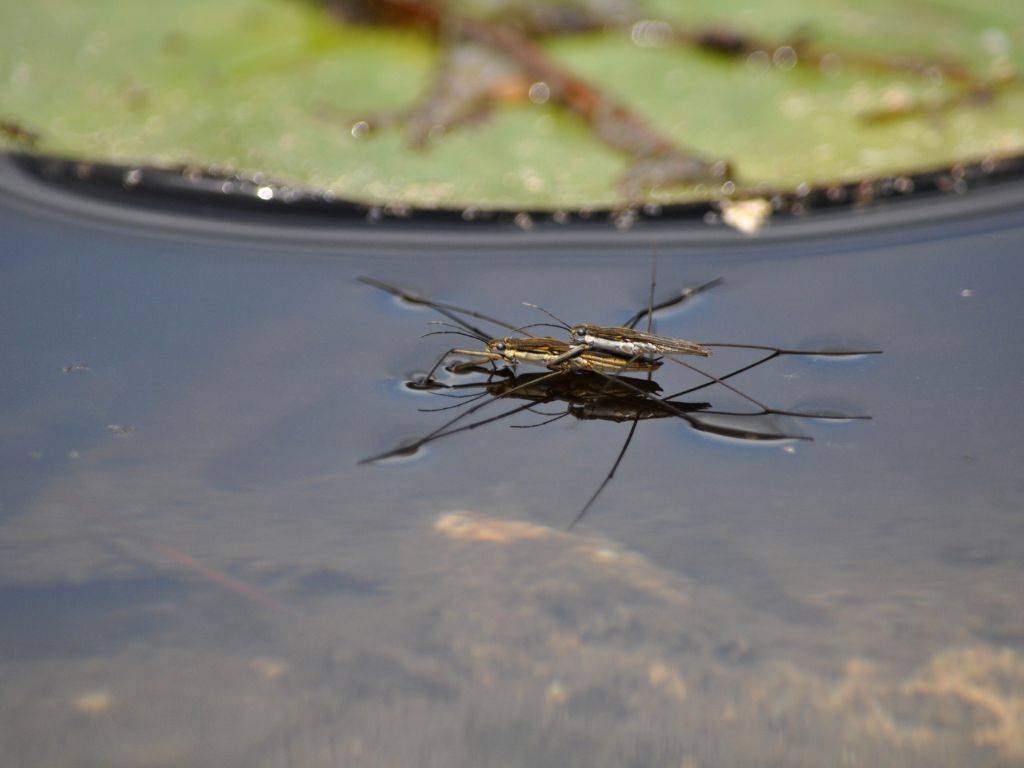
Have you ever observed mosquito-like creatures gliding effortlessly on the water’s surface? Those are likely water striders. Despite resembling pesky blood-sucking mosquitoes, water striders do not bite.
Water striders are fascinating insects with slender bodies and delicate, elongated legs. They have evolved to thrive in aquatic environments.
Their unique talent lies in their hydrophobic legs, which repel water and create air pockets, enabling them to “walk on water.” This remarkable ability allows them to swiftly navigate, search for food, and escape from predators.
Some water striders possess wings and can fly, which is why they may end up in your pool while searching for mates and new breeding grounds.
Since these insects do not sting or bite humans, their presence in your pool is not a major concern. Furthermore, water striders are actually beneficial insects!
Water striders are skilled hunters, detecting vibrations on the water surface to locate and capture their prey, primarily smaller aquatic insects like mosquito larvae and land insects that accidentally fall into the water. If water striders are present, you need not worry excessively about mosquito breeding in your pool.
Dragonfly and Damselfly Naiads

Everyone knows what dragonflies are, and damselflies are just cousins of dragonflies, with a slimmer body. However, not many know that the nymphs of dragonfly and damselfly, also known as naiads, are aquatic.
While dragonflies and damselflies exhibit different mating and egg-laying behaviors, both lay their eggs in water. These eggs hatch into six-legged, aquatic naiads that feed on other aquatic organisms like mosquito larvae and tadpoles. Older naiads have short wing buds and elongated abdomens.
Due to their predatory nature and unique appearance, one might assume that naiads can harm humans through bites or stings. However, this is not true. Naiads are beneficial insects that do not bite or sting. So, there’s no need to be alarmed when you encounter naiads in your pool.
Diving Beetles
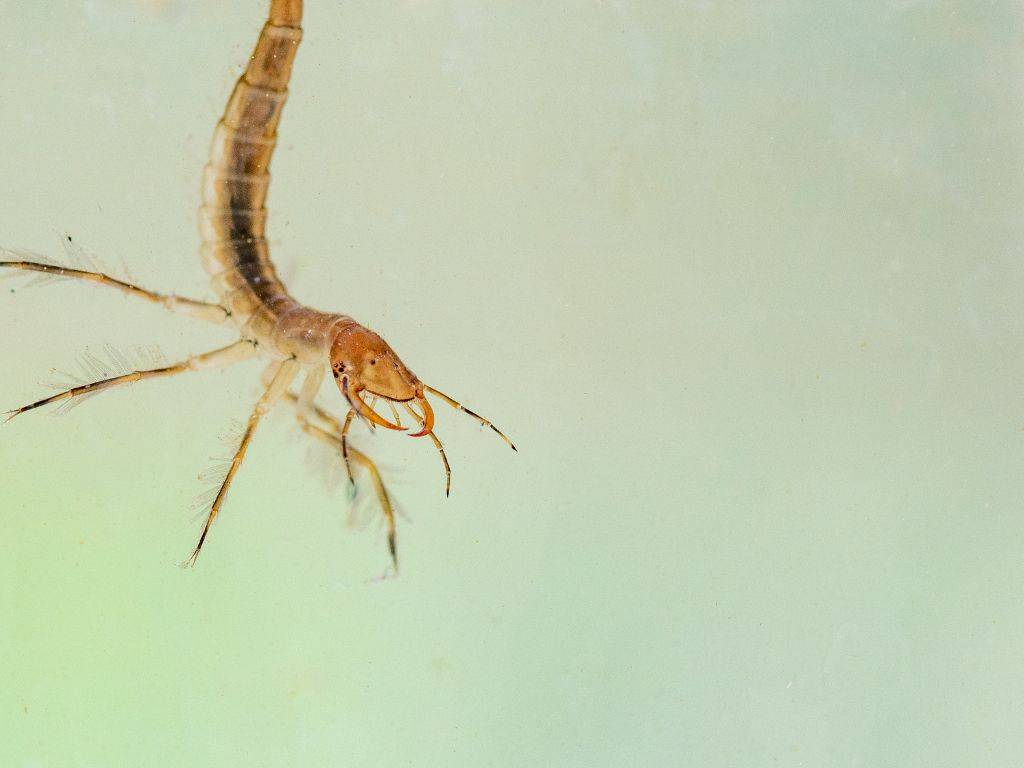
Diving beetles are predatory insects that hunt in water. Adult diving beetles can carry air bubbles under their wings to provide oxygen when diving, while the larvae are entirely aquatic.
Depending on species, adult diving beetles vary in size, ranging from 4.5 cm to as small as 1 mm in body length. The larvae are generally longer in body length. Both adults and larvae feed on a variety of aquatic animals, including small fish, tadpoles, and mosquito larvae.
The prominent and large pincers on the predaceous beetle larvae may appear intimidating. In fact, adult diving beetles also possess short, sharp pincers that are somewhat concealed. Although they can use these strong pincers to capture prey, diving beetles do not bite humans.
Since diving beetles are capable of flight, they might accidentally enter your swimming pool. However, it is highly unlikely for them to breed in your pool, as they require vegetation to lay their eggs and complete their life cycle.
Removing Bugs from the Pool
To remove bugs from your pool, simply skim the water with a net. If there are many small bugs, consider draining the water instead. Avoid using chemicals, as they can pose risks to swimmers.
How to Keep My Pool Free of Bugs
As you may have figured out, having bugs in your water pool attracts other bugs, including those that can bite. So, it is important to keep your pool bug-free. By following the steps below, you can maintain a bug-free pool and enjoy a pleasant swimming experience without unwanted visitors.
Utilize a Pool Cover When Not in Use
Covering your pool is a simple yet effective way to prevent bugs from trespassing. Various pool covers are available, including sizes and designs suitable for inflatable pools. These covers not only keep bugs out but also safeguard your pool against debris such as leaves and branches, helping to maintain its cleanliness.
Regular Pool Cleaning
Frequent pool cleaning is vital in eliminating potential food sources for aquatic bugs, including organic matter, leaves, tree branches, algae, and microscopic organisms. By removing these food sources, you make your pool less attractive to bugs while ensuring a clean and hygienic swimming environment.
Consider using a combination of methods, such as pool vacuuming, skimming the water with a net, installing a water filter (for larger pools), and regularly chlorinating the pool water.
Dim Lighting at Night
Dimming or turning off the lighting around your pool during the evening can significantly reduce the number of bugs drawn to your pool area.
Many flying insects are naturally attracted to light sources. By minimizing the lighting around your pool, you discourage these insects from gathering in the vicinity. This not only prevents annoyance and inconvenience, especially when bugs end up in the pool, but also minimizes the chances of aquatic species taking up residence in your pool if conditions are favorable.

